|
The Map Modules Compute Volume from a Grid tool calculates volumetrics from a single grid. With a good quality isopach, pore volume, or hydrocarbon pore volume grid, this method can generate accurate estimations of the area occupied by hydrocarbons, and can divide these volumetrics into different lease polygons.
Once the overlay volumetric polygons are set-up, select Contours>Volumetrics>Compute Volume From a Grid
on the menu bar at the top of the Map Module to open the volumetrics tool.
Data tab
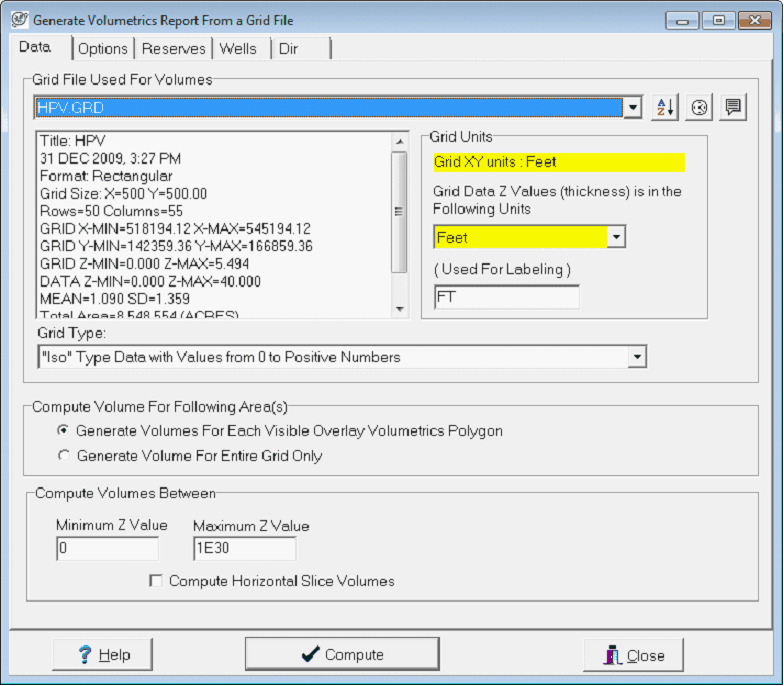
Grid File Used For Volumes
Here, select the grid and grid type to be used in the calculation from the dropdown labeled Grid File Used For Volumes. In the example below the HPV grid is selected. To change the grid directory, select a different file path on the Dir tab. Note that grids on this dropdown menu can be sorted alphabetically by selecting the  button. The button. The  button selects the most recently created grid in the directory. button selects the most recently created grid in the directory.
Grid Units
When calculating volumetrics, its important to make sure the units are correct. Petra stores the default XY and depth units of measurement (feet or meters) in the Map Projections Settings. When Petra calculates a grid, it uses these XY coordinate units. The units used to create the selected grid are shown under Grid XY Units.
By default, Petra assumes that the Z units for the grid are the Default Depths Units selected on the Map Projection Settings. Make sure the units selected here reflect the units of the grid.
Grid Type - Iso
The Grid Type dropdown tells Petra what the numerical values in the grid actually mean. A grid used in volumetrics can be one of three types: Iso type data with values from zero to positive numbers, structure data with structural highs as larger numbers, or structural data with structural highs as smaller numbers. In the example below, the SCMR ISOPACH grid is selected as an isopach.
With Iso grids (including isopach grids, pore volume grids, and hydrocarbon pore volume grids), Petra uses the thickness to calculate the volume underneath the grid nodes. This is the most common and easiest way to calculate volumetrics with a grid. Note that Petra will ignore the effect of negative numbers in Iso type grids.
Grid Type - Structure
Though Petra can use a structure grid in a volumetric calculation, it is almost always better to use an isopach grid. In practice, using a structure grid really only works with small, simple structures with a thick, homogenous reservoir and a discrete water contact.
The numerical representation of a structural high or low is dependent on the reference datum (Measured Depth/MD or SubSea/SS). SS grids store structural highs as larger numbers (e.g. +2,000 SS is higher than +1,000 SS and -1,000 SS is higher than -2,000 SS). MD grids store structural highs as smaller numbers (e.g. 1,000 MD is higher than 2,000 MD). Practically, grids referenced to SS use the Structural Highs as Larger Numbers option, while grids referenced to MD use Structural Highs as Smaller Numbers" option.
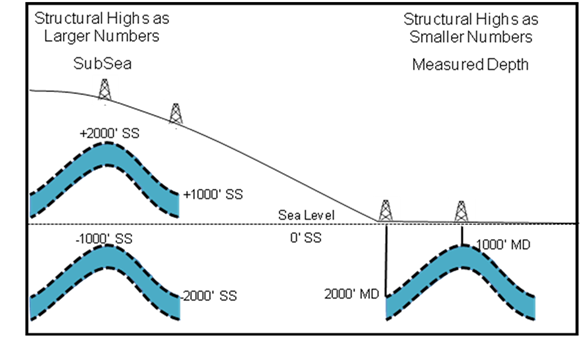
A single structure map only represents the elevations of a surface and doesnt inherently have any measurement of thickness. When using a structure map, Petra calculates thickness by using the volume of the grid between the minimum and maximum Z values set on the Data tab. In the example below, Petra will calculate a thickness between -1200 SS and -2200 SS. Its important to note that setting a limit below the bottom of the grid will add a large extra bulk to the volumetric calculation. The example below will have an additional 200 of section added to the volumetric calculation.
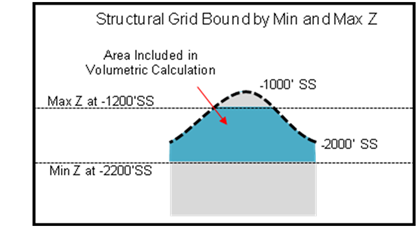
Calculating volumetrics with a structure map can also lead to problems if the thickness of the reservoir rock is thinner than the difference between the grid and the bounding lower z value. With a sufficiently thick reservoir, the bounds are completely covered by reservoir rock. With thinner reservoirs, the volumetric calculation can include a volume that doesnt actually include reservoir rock, thus overestimating the volume.
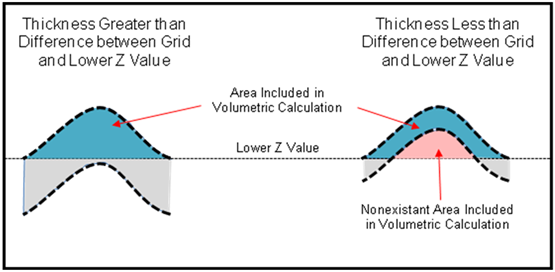
Compute Volume for Following Area(s)
This section tells Petra whether the volume underneath a grid will be broken out by different volumetric polygons. The Generate Volumes for Each Visible Overlay Volumetric Polygon option will calculate the volume of the grid covered by every visible overlay polygon. Recall that a line defining these polygons need to be closed on the lines General tab and named on the lines Volm tab. If these polygons overlap, Petra will count the volume of the shared area twice. Setting this option to Generate Volume For Entire Grid Only will instead ignore visible polygons and calculate the volume over the entire grid.
Compute Volumes Between
The Minimum and Maximum Z values set limits on the overall volumetric calculation. Though these settings are critical when using a structure grid, the limits can also be useful when calculating volumetrics on thickness or iso maps. In particular, setting the limits can help to reduce the effect of a large, thin uneconomic area on the calculation.
Horizontal Slice Volumes
Its also possible to calculate volumetrics for horizontal slices from the minimum z value to the maximum z value through the reservoir. In the example below, horizontal slices will be calculated for 0-10 of thickness, 10-20, 20-30, and so on through the entire section. With large grids and small increments, this additional step can be fairly time-consuming.
Options tab
The Options tab provides a few more options for the volumetrics calculation.
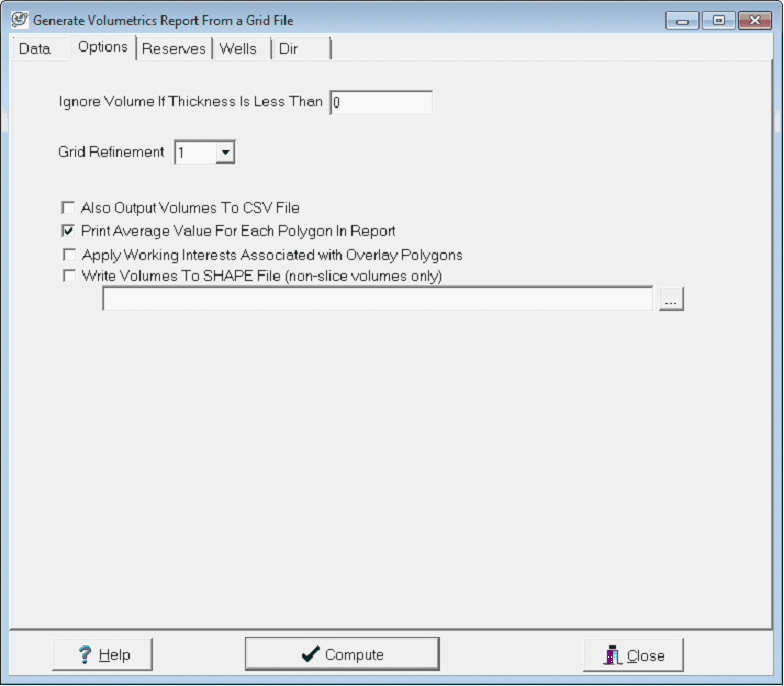
Ignore Volume if Thickness is Less Than - This option sets the minimum thickness necessary for Petra to consider in the volumetric calculation; anything below this thickness isnt included. By default, this thickness cutoff is set at zero, which means that all the entire positive volume of the grid is used. Setting this thickness higher can help to reduce the influence of a large thin or uneconomic area. Note that the cutoff thickness is relative to the selected grid units a 10 cutoff applied to an isopach grid is very different than a 10 cutoff applied to a HPV grid.
Grid Refinement - The Grid Refinement option breaks larger grid cells into smaller triangular areas. This slightly increases the accuracy of the volumetrics calculation at the cost of more computing time.
Also Output Volumes to CSV File - The Also Output Volumes to CSV File option writes a CSV file containing the name, area (both a total area of the polygon and the total area of the grid underneath the polygon), relevant calculated volume, an average grid thickness (if selected), the working interest, and the WSN of the polygons designated well. Petra creates a CSV file using the volumetric grid name in the projects GRIDS directory. Using the example above, Petra creates a file named HPV.CSV. Leaving this CSV file open while trying to calculate a new volume (and thus export data to the same CSV file) can create an IO error.

Print Average Value for each Polygon in Report - This option simply calculates the average grid thickness for each visible named polygon. What this thickness actually represents depends on the type of the grid used. The average Z value for a structure grid will be an average elevation rather than an average thickness.
Apply Working Interests Associated with Overlay Polygons - This option scales each volume inside a volumetrics polygon by the working interest.
Write Volumes to SHAPE FILE - This option saves currently visible volumetric polygons and data to a shape file. Select the option and navigate to the desired shape file. This copies all currently visible volumetric polygons to a single shape file.
Reserves tab
The Reserves tab selects the type of reserves calculation and specifies the type of input grid. The reserves types include basic volumes, recoverable oil in place, recoverable gas in place, coal bed methane, and coal tonnage. The map type tells Petra whether the input grid is an isopach, a pore volume map, or a hydrocarbon pore volume map. The Map Type only affects oil and gas reserve calculations. The options on the Reserves tab changes depending on the selected reservoir and map type. Similarly, the area and volume dropdowns at the bottom of the window show the relevant units for the specific reserves calculation.
Basic Volumes (No Scaling)
The simplest form of a volumetric calculation is the first option, Basic Volumes (No Scaling). This option simply calculates the volume occupied by the grid without any additional reservoir calculations. Note that the Map Type option has no effect on this calculation.
The Basic Volume calculation can display results in a variety of areas and formats. For area, the available units include raw units (as defined on the Units tab), square feet, square meters, and acreage. For volume, the available units include raw units (as defined on the Units tab), cubic feet, acre-feet, acre-meters, MBO, MMCF, and cubic meters.
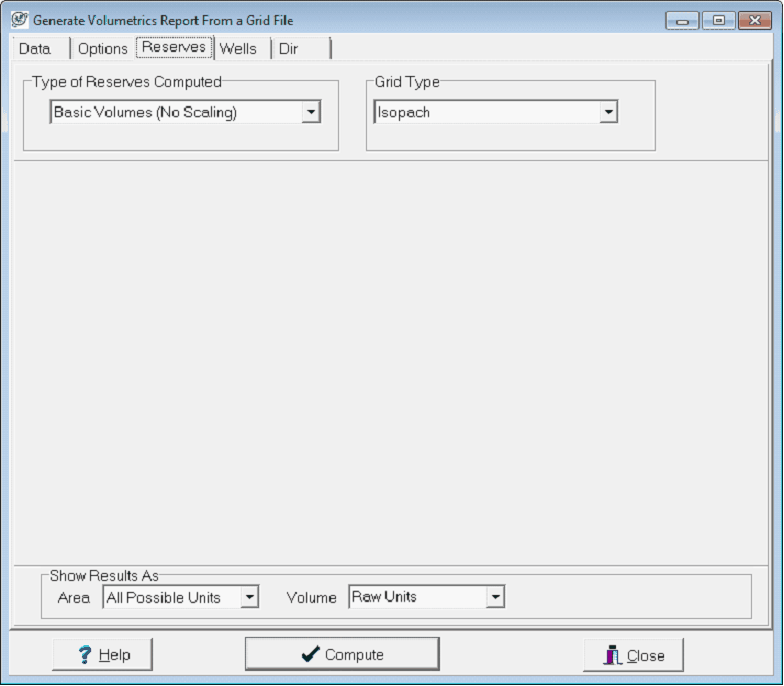
Oil in Place with Recovery
Petras oil reserves calculations multiplies the total area of pore space occupied by hydrocarbons by a recovery factor. This volume is then divided by Bo to correct for differences in volume between hydrocarbons in the reservoir and the same hydrocarbon at surface conditions.
Recoverable Oil In Place: ROIP = Volume*Por*(1-Sw)*Rf / Bo
The three options for Map Type (isopach, pore volume, and hydrocarbon pore volume) simply tell Petra what the selected grid represents. Practically, the map type grays out irrelevant options.
An isopach grid just contains thickness and will need an average water saturation and porosity. A pore volume grid already contains the thickness and porosity information and just needs average water saturation. A hydrocarbon pore volume grids already contains all this information, and therefore needs no averaged porosity and saturation information.
The Oil In Place with Recovery calculation can display results in a variety of areas and formats. For area, the available units include raw units (as defined on the Units tab), square feet, square meters, and acreage. For volume, the available units include raw units (as defined on the Units tab), cubic feet, acre-feet, acre-meters, or MBO.
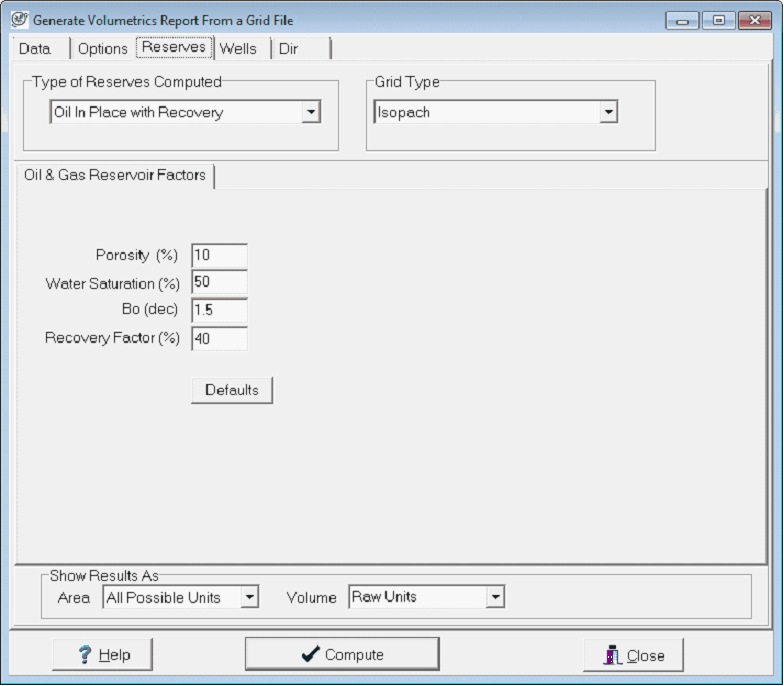
Gas in Place with Recovery
Petras oil reserves calculations multiplies the total area of pore space occupied by hydrocarbons by a recovery factor. This volume is then divided by Bg to correct for differences in volume between hydrocarbons in the reservoir and the same hydrocarbon at surface conditions.
Gas In Place: GIP = Volume*Por*(1-Sw)*Rf / Bg
Where Bg = Patm/P*(460+T/460+60)*Z; Patm = 1
The three options here for Map Type (isopach, pore volume, and hydrocarbon pore volume) simply tell Petra what the selected grid represents. Practically, the map type grays irrelevant options out.
An isopach grid just contains thickness and will need an average water saturation and porosity. A pore volume grid already contains the thickness and porosity information and just needs average water saturation. A hydrocarbon pore volume grids already contains all this information, and therefore needs no averaged porosity and saturation information.
The recoverable gas in place calculation also requires a compressibility factor, reservoir pressure, and reservoir temperature. The calculation only uses the numbers on the imperial units side; SI units must be converted to imperial units. Using imperial units is fairly simple simply enter the reservoir pressure and temperature in PSI and °F into the boxes on the left (highlighted in yellow) To use SI units, enter in the pressure and temperature in kPAA and °C into the boxes on the right (not highlighted) and select the arrow buttons  for bth pressure and temperature to convert to imperial units. After the SI pressure and temperature are converted, then compute the volumetrics normally. for bth pressure and temperature to convert to imperial units. After the SI pressure and temperature are converted, then compute the volumetrics normally.
The Gas In Place with Recovery calculation can display results in a variety of areas and formats. For area, the available units include raw units (as defined on the Units tab), square feet, square meters, and acreage. For volume, the calculation is limited to MMCF.
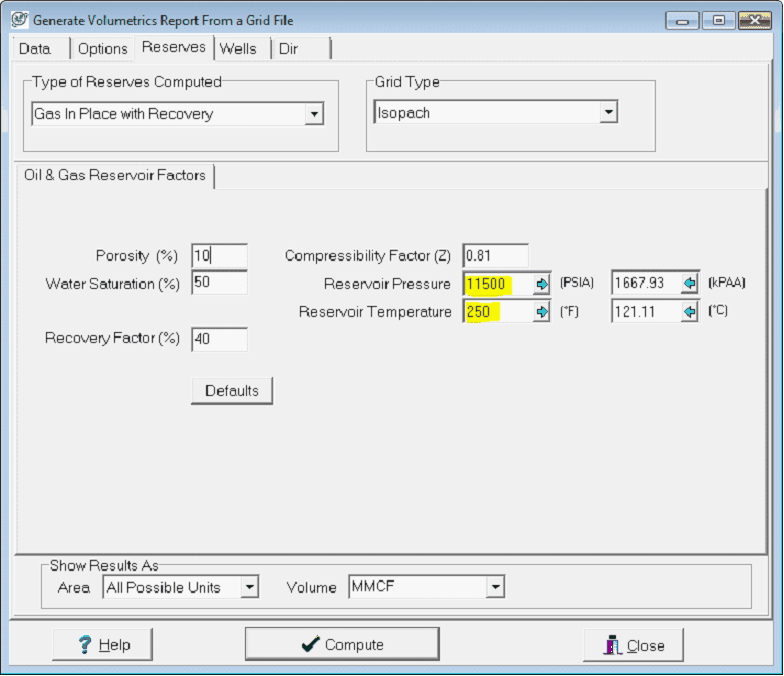
Coal Bed Methane (CBM) in Place with Recovery
The CBM Gas in Place with Recovery option calculates reserves for a coal bed methane field. Note that the Map Type option has no effect on these calculations, and the grid is always assumed to be an isopach grid.
CBM Gas In Place: CBMGIP = Volume*Cf*Gc*Sg*Rf
where Cf converts bulk density in g/cc to tons/acre-ft
The Coal Gas In Place with Recovery calculation displays results in a variety of areas and formats. For area, the available units include raw units (as defined on the Units tab), square feet, square meters, and acreage. For volume, the calculation is limited to MMCF.
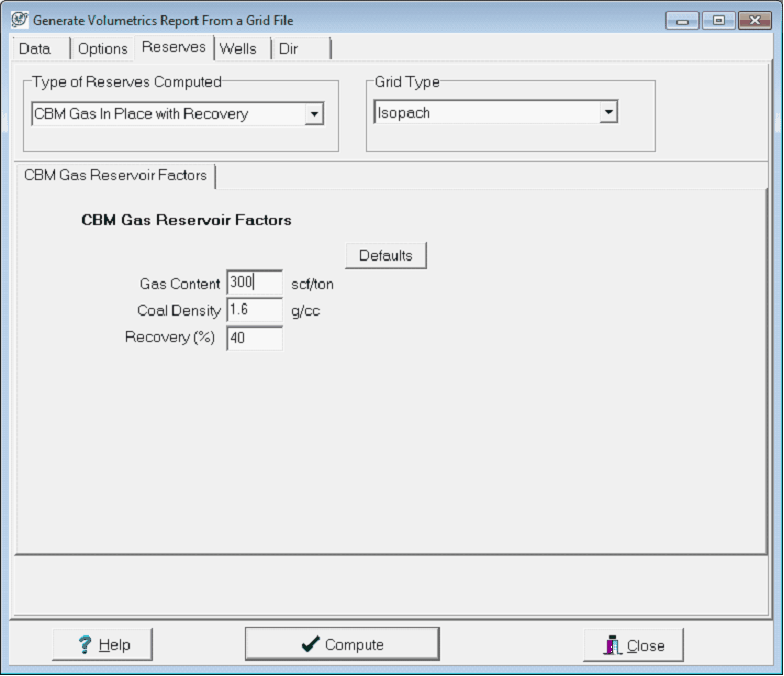
Coal Tonnage
Coal tonnage simply calculates the volumetrics of an isopach grid and multiplies this value by an average coal density.
Coal (Tons) = Volume*CoalDensity*62.42796061/2000 when density is in gm/cc
Coal (Tons) = Volume*CoalDensity/1000 when density is in kg/m3
The Coal Tonnage calculation displays results in a variety of areas and formats. For area, the available units include raw units (as defined on the Units tab), square feet, square meters, and acreage. For volume, the calculation is limited to Tons (2,000 lbs).
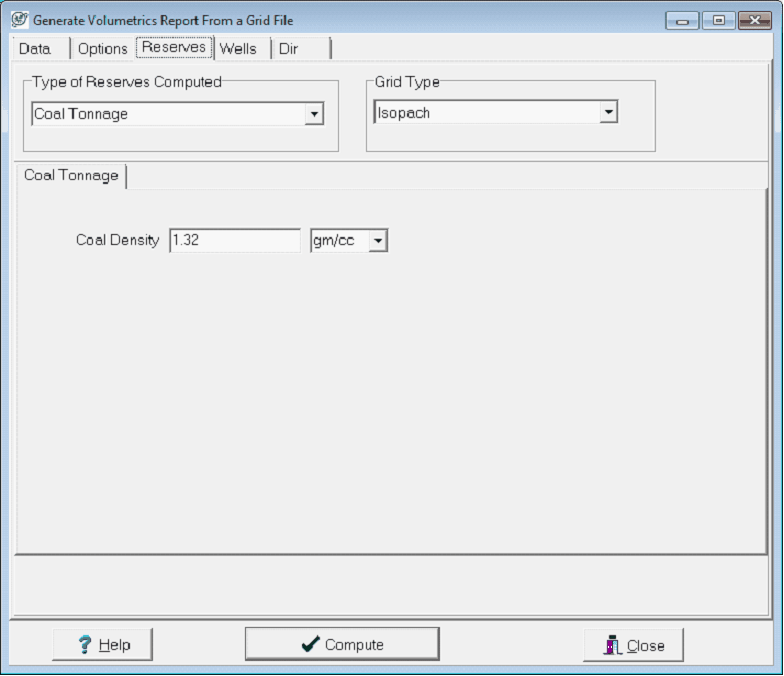
Wells tab
Petra can copy the volumetric data for each named polygon to a specific wells designated zone and data item. Recall that each polygons designated well is established by double-clicking the polygon in the map module to open its Overlay Line Attributes screen (see Initial Polygon Setup above). The Store Polygon Volume in Each Polygons Designated Well option stores the calculated volume to the designated well.
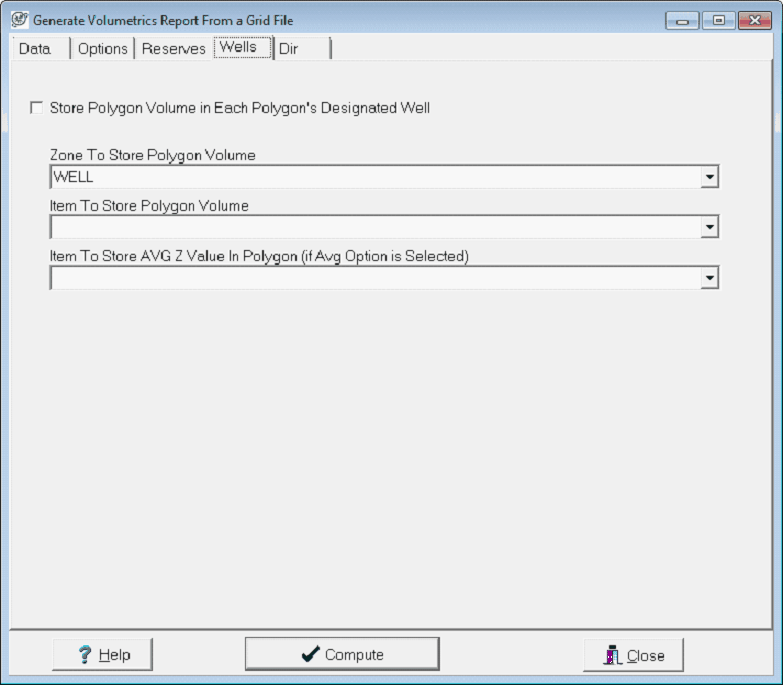
The Zone To Store Polygon Volume dropdown simply sets the zone where the relevant volumetric data will be stored. By default, volumetric data is saved in the WELL zone. In the example below, data will be stored in the VOLUMETRICS zone.
The Item to Store Polygon Volume selects the specific data item where the relevant volume is stored. In the example below, data will be stored in the GIP zone
The Item to Store AVG Z selects the specific pre-existing data item where the average grid thickness for each visible named polygon is stored. What this thickness actually represents depends on the type of the grid used Note that the Print Average Value for each Polygon in Report option on the Options tab needs to be selected for this option to work. In the example below, data will be stored in the GIP data item in the VOLUMETRICS zone.
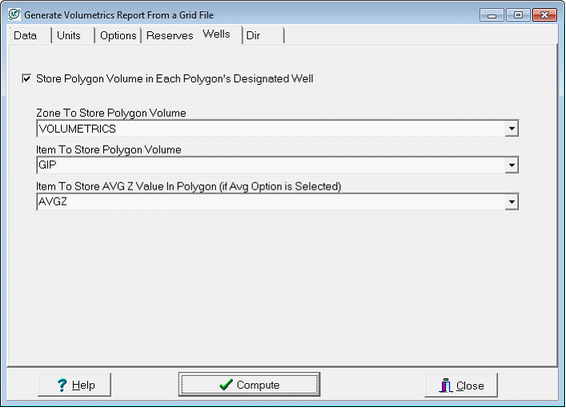
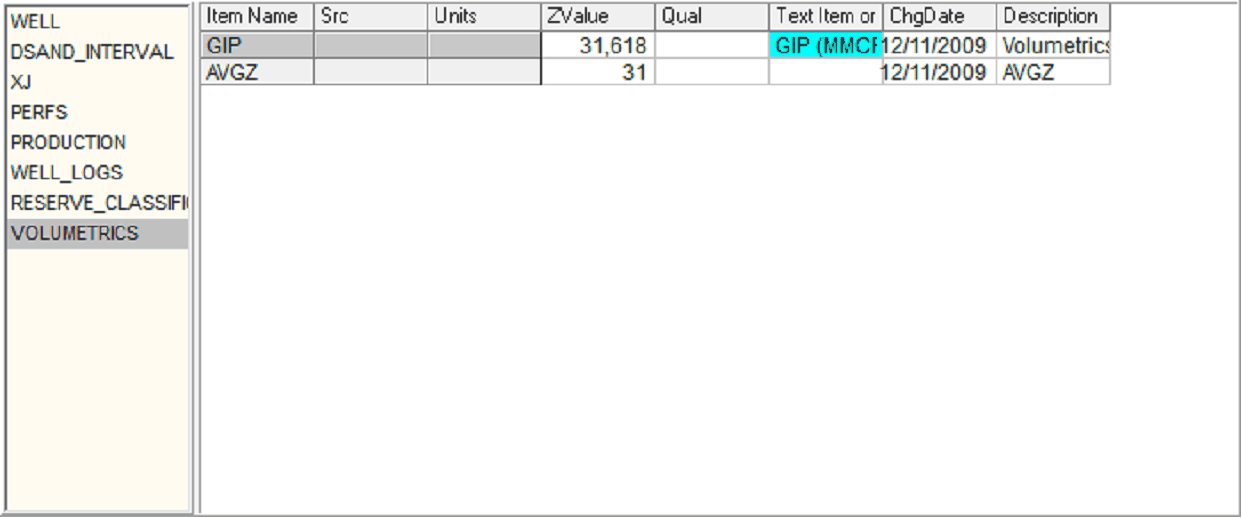
Dir tab
This tab simply sets the directory of available grids. By default, this option is set to the projects GRIDS folder.
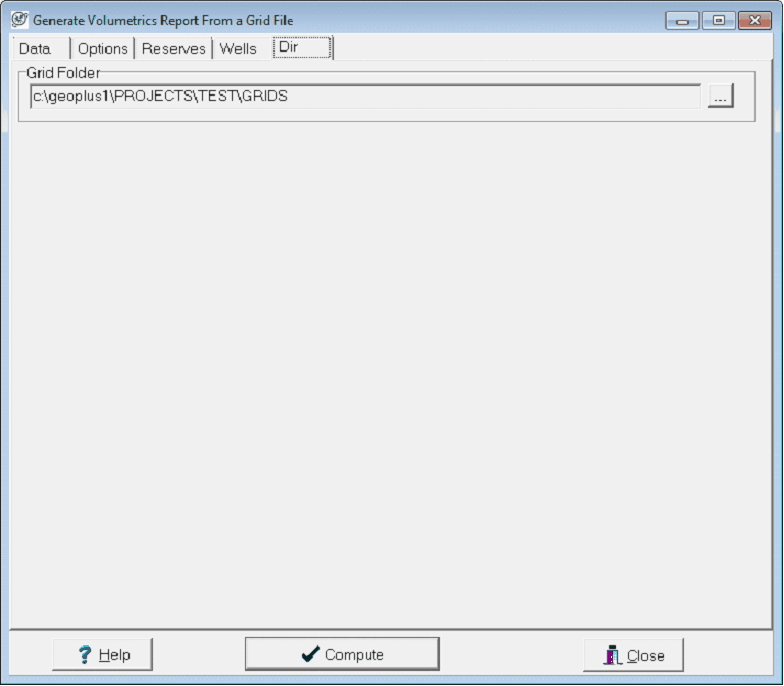
|